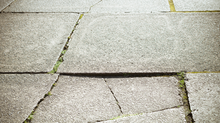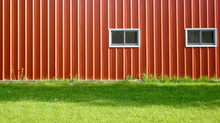Concrete Lifting FAQ
A little bewildered by the idea of concrete lifting? Here are the answers to all your burning concrete lifting questions.
How does the process work, in simple terms?
First things first, we will drill a small penny-sized hole into the affected area. Once we have an access point, we will use our equipment to inject a high-density foam into the ground underneath your failed concrete. This foam will expand and fill the voids it finds, stabilizing loose, non-compacted soil in the process.

Once the foam has reached the desired height we will stop injecting material, then fill and finish the access point to match your existing concrete. Easy!
How long does it take to lift a concrete slab?
The average residential concrete lifting job takes an hour or two — much quicker than replacement. As for commercial or municipal projects, the duration of the project depends heavily on scope.
Will my landscaping be disturbed?
Your landscaping will in no way be accessed or disturbed. We park our trucks in the street, out of the way, then pull a very lightweight, flexible hose across hard ground (like asphalt) to the job site. Not a worry!
What's the average cost of a concrete lifting job?
Generally speaking, the cost of a concrete lifting job depends heavily on the amount of material needed to achieve the desired result and the size of the slab itself. Luckily, we provide onsite estimates so there will be no question as to the expense of your particular project. Just give us a call and we'll set up a time to visit!
Is the process noisy?
The injection gun that we use to inject foam into the ground makes little to no noise. Plus, the equipment is permanently mounted on our truck, so the noise they do generate is very much contained in the unit itself.

How long do I have to wait before I can walk on my slab?
Polyurethane foam sets in minutes. Literally. You'll be able to use your concrete immediately once we leave the site, no problem.
Is there ever a situation in which concrete lifting is not an option?
Rarely. Polyurethane foam can cure in any environment — warm, cool, moist, dry. It doesn't matter! The only situation in which we might not recommend concrete lifting is if your slab is broken into several small pieces. It can be difficult to raise each small piece as evenly as we'd like.
Is the foam used in your process safe and environmentally friendly?
Absolutely! The components that make up our polyurethane foam are manufactured using entirely non-toxic, environmentally safe materials. Additionally, once the solution is mixed and injected into the ground, the polyurethane creates a sort of outer skin (like a balloon), which contains every other ingredient inside.
Is there any maintenance needed after the job is done?
The polymers we inject underneath your slab do not fail. The material is very dense and can bear a great deal of weight — far more than any packed soil. That said, due to the consistency of Front Range soils, it's possible that surrounding soils may shrink and swell with temperature changes, depending on their moisture content.
Even if there is a small shift or settlement, you should not be alarmed. There's a very good chance that the concrete will return to its original place once moisture levels stabilize with the change of the seasons.























